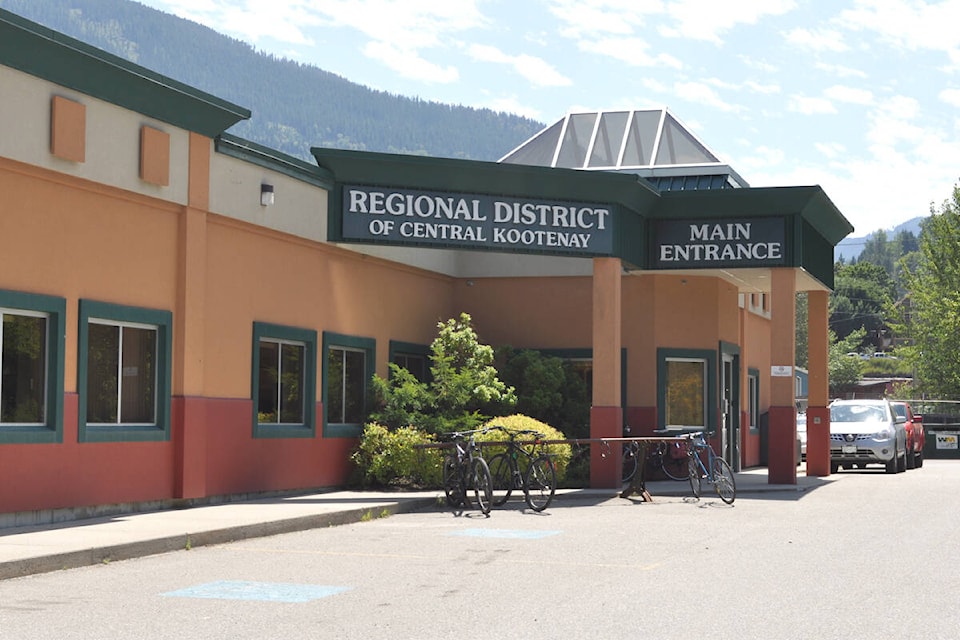by Rachael Lesosky
Local Journalism Initiative Reporter, Valley Voice
The Regional District of Central Kootenay will now record board meetings.
The recordings will be available for one year for public viewing on the RDCK website, then removed but kept in RDCK’s records for three years.
The decision comes after requests from the public for more transparent and accountable governance.
“Providing an alternative method for the public to view board meetings increases accessibility and may have an impact on the overall engagement with RDCK governance. Recorded meetings also allow for increased transparency with how the board of directors makes decisions on RDCK programs and services,” said Shiree Worden, records and information management co-ordinator, in her report to the board on the new policy.
Currently, board meetings are broadcast live online using software called Webex. Meetings can be recorded using this program, however A/V equipment may need to be updated to improve recording quality.
Recording meetings is common practice for many regional districts and municipalities. While creating the policy, staff examined other region districts’ policies and means of recording.
During the board meeting on March 21, the board debated how long recordings should be kept on record.
Area A Director Garry Jackman and City of Castlegar Director and Mayor Maria McFadden were in favour of up to seven years.
Worden explained that meeting minutes serve as the official records of board meetings; video recordings are primarily to enhance meeting minutes and increase access to board meetings. She wrote in her staff report that “retaining transitory information beyond necessity risks undermining the official record.”
More practically, computer files of recordings are large, up to 2.4 gigabytes per hour. Board meetings begin at 9 a.m. and can run until 3 p.m. Storage costs will vary depending on the storage method, but staff estimates it could cost $1,000 per year to store the recordings.
After some discussion, the board agreed that meetings will be available to the public for one year on the RDCK’s website. The recordings will be retained in RDCK records for three years, but the board will revisit the policy in the future.
The policy applies to regular board meetings and special board meetings. It does not apply to committee, commission, department or staff meetings.
Kootenay Mountaineering Club
The Kootenay Mountaineering Club wants more environmentally sound outhouses at its backcountry huts, and has applied to the RDCK’s Community Works Fund for assistance.
David Heyduck and Sandra Fuller of KMC made a presentation to the board about this first phase of the project to build barrel outhouses at Grassy and Lost Lake backcountry huts. KMC has already secured $10,000 from each of Areas G, H, I, and J, but still needs $19,050 for the $59,050 project.
Phase two of the project will see barrel outhouses at the KMC’s remaining three huts. KMC, a not-for-profit society that has promoted non-motorized outdoor recreation in the Kootenays since the 1980s, has built and manages a network of five backcountry huts in the Bonnington Range.
Currently, the huts use pit outhouses, which are placed in the terrain with a shallow soil bed and limited drainage. Grey water is discarded on the ground outside the huts.
A better, more sustainable solution is barrel outhouses, elevated structures that collect waste in capped barrels. The barrels are removed, emptied, and replaced annually via helicopter.
“We feel strongly that taking waste off the mountain is the right answer for the future of sustainability, and protecting our watersheds,” said Heyduck.
Area D roads
The roads in Area D (North Kootenay Lake) are in rough shape, and Area D Director Aimee Watson has asked for a public meeting, hosted by the Ministry of Transportation and Infrastructure and Nelson-Creston MLA Brittny Anderson.
“They are in a terrible state!” writes Watson in her monthly report to her constituents. “I have never heard of so many safety-related issues.”
She said the road to Marblehead and beyond is limited to under five km/h “to be sure the washboard does not throw you off the road.”
Argenta/Johnsons Landing Road is also suffering from washboard, with further erosion from lack of usual spring loading restrictions. Farther north, residents are filling in potholes themselves.
Watson and Chelsey Jones of Lardeau Valley Opportunity LINKS Society created a report on the state of Area D’s roads, forwarded it to Anderson, who forwarded it to the Minister of Transportation.
“The indication was that [the Ministry of Transportation] will ensure all operational repairs are completed as soon as possible,” wrote Watson.
The ministry will also review why load restrictions have not been put in place.
RDCK facility management
Management of RDCK facilities could improve if an application to the FortisBC Education and Behaviour Programs Fund is successful.
The funds would support the Energy Wise Network (EWN) project, expected to cost between $30,000 and $40,000.
“The EWN project is a training and peer network opportunity for facility managers and operators across RDCK services with the objectives to gain a better understanding of how their building(s) operate, tips for optimizing performance, and long-term planning strategies,” wrote Imada in her staff report.
In particular, training would address energy efficiency and carbon reduction practices. The training, in tandem with a peer network, would ensure there is consistency across RDCK facilities when it comes to energy efficiency and greenhouse gas emissions reduction.
New staff position
The board approved a staffing request for an additional full-time emergency program co-ordinator at the Nelson office.
The new hire will join the existing co-ordinator in preparing for, responding to, and recovering from “the increasing frequency, intensity, and uncertainty of hazards such as floods, wildfires, drought, and extreme heat.”
The position is also needed, says a staff report, because the new provincial Emergency and Disaster Management Act expands the responsibilities of local governments and thus adds to the workload of the RDCK’s Emergency Management Program staff.
The proposed new co-ordinator’s salary and benefits will not exceed $103,625 per year. It will be prorated in 2024 due to a later start date.
